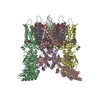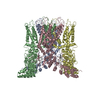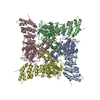[English] 日本語
 Yorodumi
Yorodumi- PDB-7mij: Mouse TRPV3 in MSP2N2 nanodiscs, closed state at 4 degrees Celsius -
+ Open data
Open data
- Basic information
Basic information
| Entry | Database: PDB / ID: 7mij | |||||||||||||||
|---|---|---|---|---|---|---|---|---|---|---|---|---|---|---|---|---|
| Title | Mouse TRPV3 in MSP2N2 nanodiscs, closed state at 4 degrees Celsius | |||||||||||||||
 Components Components | Transient receptor potential cation channel subfamily V member 3 | |||||||||||||||
 Keywords Keywords |  MEMBRANE PROTEIN / Transient Receptor Potential V Family Member 3 / MEMBRANE PROTEIN / Transient Receptor Potential V Family Member 3 /  TRP channel / TRP channel /  TRPV3 / closed state at 4 degrees Celsius / MSP2N2 TRPV3 / closed state at 4 degrees Celsius / MSP2N2 | |||||||||||||||
| Function / homology |  Function and homology information Function and homology informationnegative regulation of hair cycle /  TRP channels / response to temperature stimulus / positive regulation of calcium ion import / monoatomic cation channel activity / TRP channels / response to temperature stimulus / positive regulation of calcium ion import / monoatomic cation channel activity /  calcium channel activity / monoatomic ion channel activity / calcium channel activity / monoatomic ion channel activity /  receptor complex / receptor complex /  membrane / identical protein binding membrane / identical protein bindingSimilarity search - Function | |||||||||||||||
| Biological species |   Mus musculus (house mouse) Mus musculus (house mouse) | |||||||||||||||
| Method |  ELECTRON MICROSCOPY / ELECTRON MICROSCOPY /  single particle reconstruction / single particle reconstruction /  cryo EM / Resolution: 1.98 Å cryo EM / Resolution: 1.98 Å | |||||||||||||||
 Authors Authors | Neuberger, A. / Nadezhdin, K.D. / Sobolevsky, A.I. | |||||||||||||||
| Funding support |  United States, 4items United States, 4items
| |||||||||||||||
 Citation Citation |  Journal: Nat Struct Mol Biol / Year: 2021 Journal: Nat Struct Mol Biol / Year: 2021Title: Structural mechanism of heat-induced opening of a temperature-sensitive TRP channel. Authors: Kirill D Nadezhdin / Arthur Neuberger / Yuri A Trofimov / Nikolay A Krylov / Viktor Sinica / Nikita Kupko / Viktorie Vlachova / Eleonora Zakharian / Roman G Efremov / Alexander I Sobolevsky /    Abstract: Numerous physiological functions rely on distinguishing temperature through temperature-sensitive transient receptor potential channels (thermo-TRPs). Although the function of thermo-TRPs has been ...Numerous physiological functions rely on distinguishing temperature through temperature-sensitive transient receptor potential channels (thermo-TRPs). Although the function of thermo-TRPs has been studied extensively, structural determination of their heat- and cold-activated states has remained a challenge. Here, we present cryo-EM structures of the nanodisc-reconstituted wild-type mouse TRPV3 in three distinct conformations: closed, heat-activated sensitized and open states. The heat-induced transformations of TRPV3 are accompanied by changes in the secondary structure of the S2-S3 linker and the N and C termini and represent a conformational wave that links these parts of the protein to a lipid occupying the vanilloid binding site. State-dependent differences in the behavior of bound lipids suggest their active role in thermo-TRP temperature-dependent gating. Our structural data, supported by physiological recordings and molecular dynamics simulations, provide an insight for understanding the molecular mechanism of temperature sensing. | |||||||||||||||
| History |
|
- Structure visualization
Structure visualization
| Movie |
 Movie viewer Movie viewer |
|---|---|
| Structure viewer | Molecule:  Molmil Molmil Jmol/JSmol Jmol/JSmol |
- Downloads & links
Downloads & links
- Download
Download
| PDBx/mmCIF format |  7mij.cif.gz 7mij.cif.gz | 493.2 KB | Display |  PDBx/mmCIF format PDBx/mmCIF format |
|---|---|---|---|---|
| PDB format |  pdb7mij.ent.gz pdb7mij.ent.gz | 429.8 KB | Display |  PDB format PDB format |
| PDBx/mmJSON format |  7mij.json.gz 7mij.json.gz | Tree view |  PDBx/mmJSON format PDBx/mmJSON format | |
| Others |  Other downloads Other downloads |
-Validation report
| Arichive directory |  https://data.pdbj.org/pub/pdb/validation_reports/mi/7mij https://data.pdbj.org/pub/pdb/validation_reports/mi/7mij ftp://data.pdbj.org/pub/pdb/validation_reports/mi/7mij ftp://data.pdbj.org/pub/pdb/validation_reports/mi/7mij | HTTPS FTP |
|---|
-Related structure data
| Related structure data |  23853MC  7mikC  7milC  7mimC  7minC  7mioC M: map data used to model this data C: citing same article ( |
|---|---|
| Similar structure data |
- Links
Links
- Assembly
Assembly
| Deposited unit | 
|
|---|---|
| 1 |
|
- Components
Components
| #1: Protein | Mass: 92630.695 Da / Num. of mol.: 4 Source method: isolated from a genetically manipulated source Source: (gene. exp.)   Mus musculus (house mouse) / Gene: Trpv3 / Production host: Mus musculus (house mouse) / Gene: Trpv3 / Production host:   Homo sapiens (human) / References: UniProt: Q8K424 Homo sapiens (human) / References: UniProt: Q8K424#2: Chemical | ChemComp-POV / (  POPC POPC#3: Chemical | #4: Water | ChemComp-HOH / |  Water WaterHas ligand of interest | N | |
|---|
-Experimental details
-Experiment
| Experiment | Method:  ELECTRON MICROSCOPY ELECTRON MICROSCOPY |
|---|---|
| EM experiment | Aggregation state: PARTICLE / 3D reconstruction method:  single particle reconstruction single particle reconstruction |
- Sample preparation
Sample preparation
| Component | Name: Transient receptor potential cation channel subfamily V member 3 Type: COMPLEX / Entity ID: #1 / Source: RECOMBINANT | |||||||||||||||||||||||||
|---|---|---|---|---|---|---|---|---|---|---|---|---|---|---|---|---|---|---|---|---|---|---|---|---|---|---|
| Molecular weight | Value: 0.9247 MDa / Experimental value: NO | |||||||||||||||||||||||||
| Source (natural) | Organism:   Mus musculus (house mouse) Mus musculus (house mouse) | |||||||||||||||||||||||||
| Source (recombinant) | Organism:   Homo sapiens (human) Homo sapiens (human) | |||||||||||||||||||||||||
| Buffer solution | pH: 8 | |||||||||||||||||||||||||
| Buffer component |
| |||||||||||||||||||||||||
| Specimen | Conc.: 1.6 mg/ml / Embedding applied: NO / Shadowing applied: NO / Staining applied : NO / Vitrification applied : NO / Vitrification applied : YES : YES | |||||||||||||||||||||||||
| Specimen support | Grid material: GOLD / Grid mesh size: 200 divisions/in. / Grid type: C-flat-1.2/1.3 | |||||||||||||||||||||||||
Vitrification | Instrument: FEI VITROBOT MARK IV / Cryogen name: ETHANE / Humidity: 100 % / Chamber temperature: 277 K |
- Electron microscopy imaging
Electron microscopy imaging
| Experimental equipment |  Model: Titan Krios / Image courtesy: FEI Company |
|---|---|
| Microscopy | Model: TFS KRIOS |
| Electron gun | Electron source : :  FIELD EMISSION GUN / Accelerating voltage: 300 kV / Illumination mode: FLOOD BEAM FIELD EMISSION GUN / Accelerating voltage: 300 kV / Illumination mode: FLOOD BEAM |
| Electron lens | Mode: BRIGHT FIELD Bright-field microscopy / Nominal defocus max: -2000 nm / Nominal defocus min: -800 nm / Cs Bright-field microscopy / Nominal defocus max: -2000 nm / Nominal defocus min: -800 nm / Cs : 2.7 mm : 2.7 mm |
| Image recording | Average exposure time: 2.5 sec. / Electron dose: 58 e/Å2 / Film or detector model: GATAN K3 (6k x 4k) / Num. of grids imaged: 1 / Num. of real images: 9702 |
| Image scans | Width: 5760 / Height: 4092 |
- Processing
Processing
| EM software |
| ||||||||||||||||||||||||||||||||||||||||
|---|---|---|---|---|---|---|---|---|---|---|---|---|---|---|---|---|---|---|---|---|---|---|---|---|---|---|---|---|---|---|---|---|---|---|---|---|---|---|---|---|---|
CTF correction | Type: NONE | ||||||||||||||||||||||||||||||||||||||||
| Particle selection | Num. of particles selected: 4662531 | ||||||||||||||||||||||||||||||||||||||||
3D reconstruction | Resolution: 1.98 Å / Resolution method: FSC 0.143 CUT-OFF / Num. of particles: 372121 / Symmetry type: POINT | ||||||||||||||||||||||||||||||||||||||||
| Atomic model building | Space: REAL |
 Movie
Movie Controller
Controller

















 PDBj
PDBj






